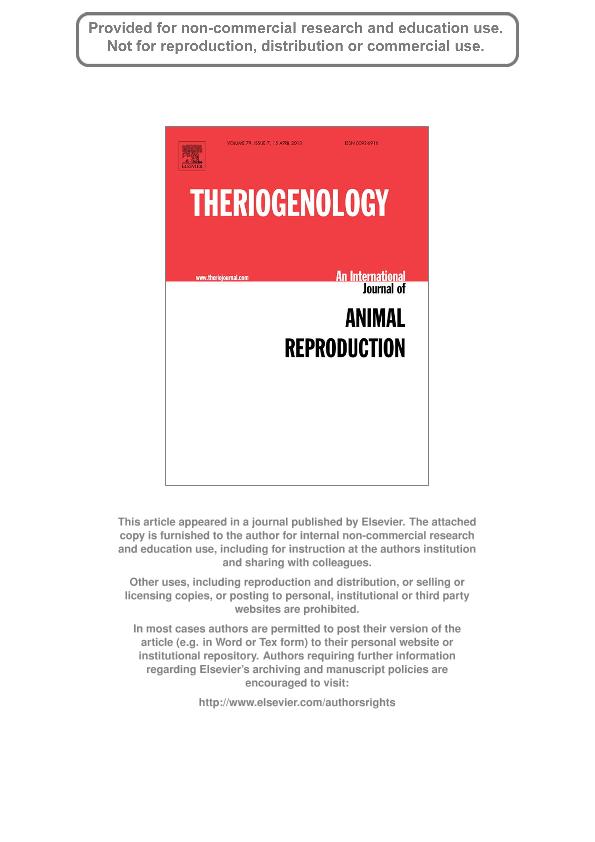Mostrar el registro sencillo del ítem
dc.contributor.author
Piehl, Lidia Leonor

dc.contributor.author
Fischman, Maria Laura

dc.contributor.author
Hellman, Ulf
dc.contributor.author
Cisale, Humberto Osvaldo

dc.contributor.author
Miranda, Patricia Vivian

dc.date.available
2020-01-10T19:02:26Z
dc.date.issued
2013-04
dc.identifier.citation
Piehl, Lidia Leonor; Fischman, Maria Laura; Hellman, Ulf; Cisale, Humberto Osvaldo; Miranda, Patricia Vivian; Boar seminal plasma exosomes: Effect on sperm function and protein identification by sequencing; Elsevier Science Inc; Theriogenology; 79; 7; 4-2013; 1071-1082
dc.identifier.issn
0093-691X
dc.identifier.uri
http://hdl.handle.net/11336/94335
dc.description.abstract
Mammalian seminal plasma contains membranous vesicles (exosomes), with a high content of cholesterol and sphingomyelin and a complex protein composition. Their physiological role is uncertain because sperm stabilization and activation effects have been reported. To analyze a putative modulatory role for semen exosomes on sperm activity in the boar, the effects of these vesicles on several sperm functional parameters were examined. Additionally, boar exosome proteins were sequenced and their incorporation into sperm was explored. Boar sperm were incubated under conditions that induce capacitation, manifested as increased tyrosine phosphorylation, cholesterol loss and greater fluidity in apical membranes, and the ability to undergo the lysophosphatidylcholine-induced acrosome reaction. After establishing this cluster of capacitation-dependent functional parameters, the effect produced by exosomes when present during or after sperm capacitation was analyzed. Exosomes inhibited the capacitation-dependent cholesterol efflux and fluidity increase in apical membranes, and the disappearance of a 14-kD phosphorylated polypeptide. In contrast, the acrosome reaction (spontaneous and lysophosphatidylcholine-induced) was not affected, and sperm binding to the oocyte zona pellucida was reduced only when vesicles were present during gamete coincubation. Liposomes with a lipid composition similar to that present in exosomes mimicked these effects, except the one on zona pellucida binding. Interaction between exosomes and sperm was confirmed by transfer of aminopeptidase activity. In addition, the major exosome protein, identified as actin, appeared to associate with sperm after coincubation. Exosome composition had a predominance for structural proteins (actin, plastin, ezrin, and condensin), enzymes, and several porcine seminal plasma-specific polypeptides (e.g., spermadhesins). Transfer of proteins from exosome to sperm and their ability to block cholesterol efflux supports a direct interaction between these vesicles and sperm, whereas inhibition of some capacitation-dependent features suggests a stabilizing function for exosomes in boar semen.
dc.format
application/pdf
dc.language.iso
eng
dc.publisher
Elsevier Science Inc

dc.rights
info:eu-repo/semantics/openAccess
dc.rights.uri
https://creativecommons.org/licenses/by-nc-sa/2.5/ar/
dc.subject
BOAR
dc.subject
EXOSOME
dc.subject
PROSTASOME
dc.subject
SEMINAL PLASMA
dc.subject
SPERM CAPACITATION
dc.subject.classification
Ciencias Veterinarias

dc.subject.classification
Ciencias Veterinarias

dc.subject.classification
CIENCIAS AGRÍCOLAS

dc.title
Boar seminal plasma exosomes: Effect on sperm function and protein identification by sequencing
dc.type
info:eu-repo/semantics/article
dc.type
info:ar-repo/semantics/artículo
dc.type
info:eu-repo/semantics/publishedVersion
dc.date.updated
2020-01-10T15:03:08Z
dc.journal.volume
79
dc.journal.number
7
dc.journal.pagination
1071-1082
dc.journal.pais
Países Bajos

dc.journal.ciudad
Amsterdam
dc.description.fil
Fil: Piehl, Lidia Leonor. Consejo Nacional de Investigaciones Científicas y Técnicas. Oficina de Coordinación Administrativa Houssay. Instituto de Bioquímica y Medicina Molecular. Universidad de Buenos Aires. Facultad Medicina. Instituto de Bioquímica y Medicina Molecular; Argentina
dc.description.fil
Fil: Fischman, Maria Laura. Universidad de Buenos Aires. Facultad de Ciencias Veterinarias. Instituto de Investigacion y Tecnología en Reproducción Animal; Argentina. Consejo Nacional de Investigaciones Científicas y Técnicas; Argentina
dc.description.fil
Fil: Hellman, Ulf. Ludwig Institute for Cancer Research; Suecia
dc.description.fil
Fil: Cisale, Humberto Osvaldo. Universidad de Buenos Aires. Facultad de Ciencias Veterinarias. Instituto de Investigacion y Tecnología en Reproducción Animal; Argentina. Consejo Nacional de Investigaciones Científicas y Técnicas; Argentina
dc.description.fil
Fil: Miranda, Patricia Vivian. Consejo Nacional de Investigaciones Científicas y Técnicas. Instituto de Biología y Medicina Experimental. Fundación de Instituto de Biología y Medicina Experimental. Instituto de Biología y Medicina Experimental; Argentina
dc.journal.title
Theriogenology

dc.relation.alternativeid
info:eu-repo/semantics/altIdentifier/url/https://www.sciencedirect.com/science/article/pii/S0093691X13000502
dc.relation.alternativeid
info:eu-repo/semantics/altIdentifier/doi/https://doi.org/10.1016/j.theriogenology.2013.01.028
Archivos asociados
